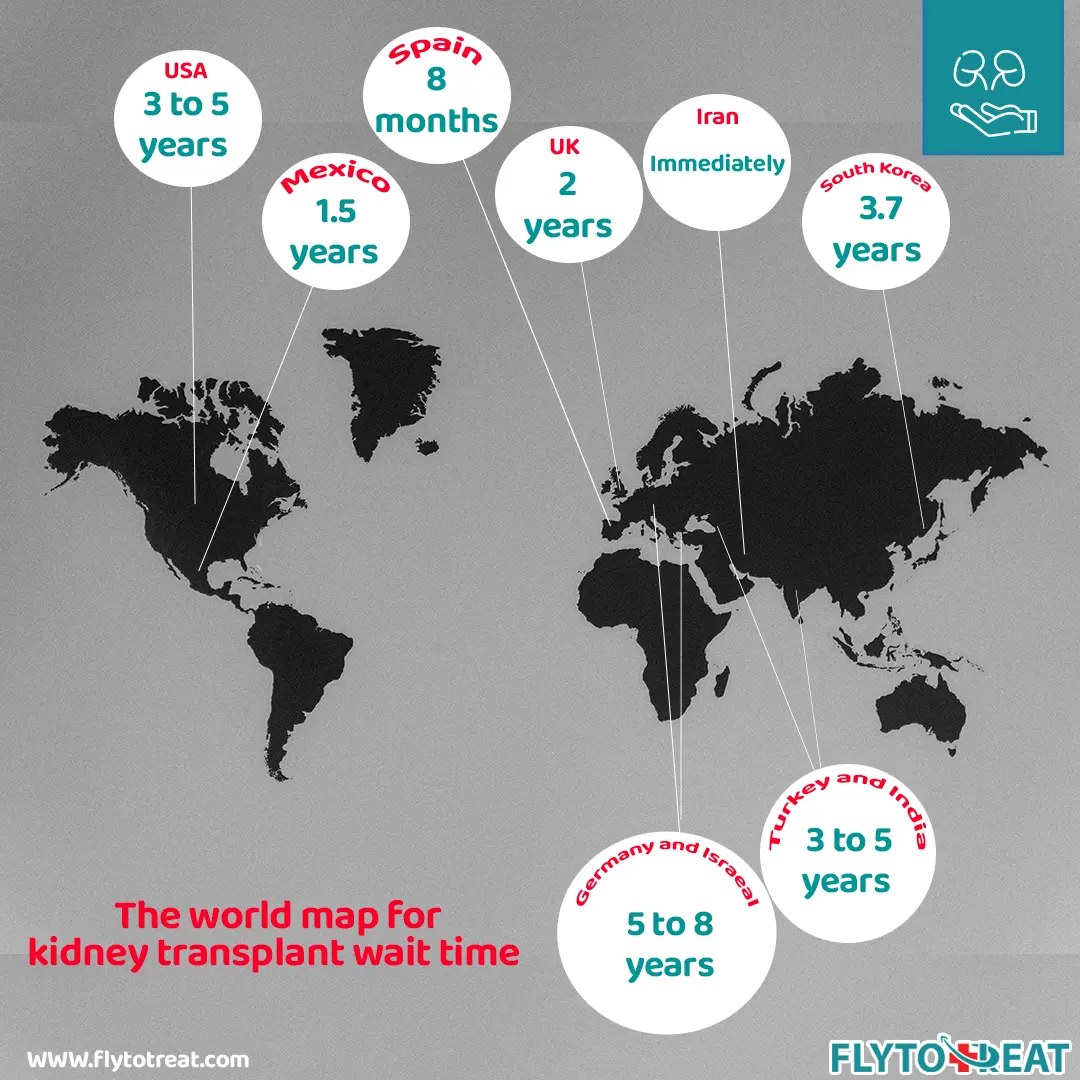
How to get kidney transplant faster?
Suppose you're seeking the fastest way to get a kidney transplant. In that case, understanding the complexities of the process and exploring different countries' regulations can make a significant difference. This article aims to answer questions like "What is the shortest kidney transplant waiting list?", "How long is the wait for a kidney transplant?", and "How to get a kidney transplant fast." FlyToTreat is dedicated to providing comprehensive information to help you navigate the transplant journey effectively.
Shortest Kidney Transplant Waiting List
The shortest kidney transplant waiting list varies significantly by country; understanding these differences can help plan a transplant.
• Iran: Offers a unique advantage with less than 12 months of waiting time for locals and no waiting list for international patients. Some of Kidney transplant centers with shortest wait time in Iran include Farhikhtegan, Rasool Akram, and SH. Hasheminezhad.
• Spain: Known for its efficient organ donation system, Spain has a waiting list of less than eight months.
• United Kingdom: The wait time averages around two years, though recent efforts have reduced this by 18%.
• Mexico: Has a relatively short waiting list of about 1.5 years.
• South Korea: Patients typically wait around 3.7 years.
• United States, Turkey, and India: These countries have waiting lists ranging from 3 to 5 years.
• Germany and Israel: Patients face longer waits, with Germany exceeding eight years and Israel at around five years.
For those seeking the fastest way to get a kidney transplant, exploring options in countries with shorter waiting times is crucial. Understanding how to apply for a kidney transplant is essential to streamline the process and reduce waiting times.
Here is a Kidney transplant wait times map:

How to Get a Kidney Transplant Faster
Understanding how to apply for kidney transplants at diverse centers and maintaining good health can expedite the process. To achieve the shortest wait time for a kidney transplant, consider these strategies:
• Living Donor: Opt for a living donor transplant. This can significantly reduce waiting time as it bypasses the deceased donor list.
• Multiple Listings: Register at numerous transplant centers in different regions to increase your chances. Each center has its waiting list and criteria.
• Paired Exchange Programs: Participate in kidney-paired exchange programs, where incompatible donor-recipient pairs swap kidneys.
• Optimize Health: Maintain optimal health to improve your Kidney Donor Profile Index (KDPI) score. Better health increases your priority on the transplant list.
• Explore International Options: Consider countries with shorter waiting lists, such as Iran, Spain, and Mexico. For instance, Iran offers less than 12 months' wait for locals and immediate availability for foreigners, making it the fastest way to get a kidney transplant internationally.
I Need a Kidney Donor Now
Understanding how to apply for a kidney transplant and leveraging various donor programs can significantly reduce waiting times and increase your chances of finding a donor quickly. If you urgently need a kidney donor, consider the following steps:
• Living Donor Program: Enroll in a living donor program. Living donors can be relatives, friends, or strangers willing to donate. This can offer the shortest wait time for kidney transplant compared to deceased donors.
• Kidney Exchange Programs: Join kidney-paired exchange programs. These programs match incompatible donor-recipient pairs with others, facilitating a swap to ensure compatibility.
• Social Media and Campaigns: Use social media platforms and community campaigns to find potential donors. Many recipients have successfully found donors through these means.
• National and International Listings: Register with multiple transplant centers and explore international options. Countries like Iran offer immediate availability for foreigners, providing one of the fastest ways to get a kidney transplant.
• Medical and Financial Preparation: Ensure you meet the health criteria and have the financial means to support the transplant process.
Can You Get a Kidney Transplant from Anyone?
A kidney transplant is not as simple as getting a kidney from anyone. The compatibility between donor and recipient is critical for a successful transplant. The donor must be in good health and ideally have a compatible blood type and tissue type to minimize the risk of rejection. Blood type O is a universal donor, while type AB is a universal recipient. Tissue typing and crossmatching are performed to ensure compatibility, as mismatched antigens can lead to rejection.
Living donors, who often provide the shortest wait time for kidney transplants, undergo rigorous evaluations to ensure they are suitable candidates. These evaluations include blood tests, imaging studies, and psychosocial assessments. Living donor transplants often result in better outcomes and shorter kidney transplant waiting lists.
To find the fastest way to get a kidney transplant, potential recipients must undergo comprehensive medical evaluations. They may join a waiting list for deceased donors. However, identifying a living donor through family or friends can expedite the process. Learning how to apply for a kidney transplant and how fast you can get a kidney transplant depends on these critical compatibility tests and the availability of a suitable donor.
You can learn more by reading what are the requirements for kidney transplant؟
How hard is it to get a kidney transplant
Getting a kidney transplant can be a challenging and lengthy process. The complexity arises from the need for a compatible donor, rigorous medical evaluations, and the time spent on the waiting list. Patients who cannot find a living donor must join a transplant waiting list for a deceased donor, which often means waiting several years. The process involves numerous steps, including comprehensive medical and psychological evaluations, to ensure the patient is fit for the transplant.
In the United States, the average wait time can vary significantly depending on factors like blood type, overall health, and the availability of donors. Finding the fastest way to get a kidney transplant often involves exploring living donor options, as this can drastically reduce the wait time. However, extensive testing and legal clearances are required even with a living donor.
For those wondering how to apply for a kidney transplant or how fast you can get a kidney transplant, it is essential to understand that the journey is often long and requires patience and resilience.
which country has the easiest rules for kidney transplant?
Kidney transplant laws vary significantly across different countries. In the United States, the process is regulated by federal and state laws that ensure ethical practices and prioritize patient safety. How to apply for kidney transplant involves adhering to these stringent regulations, which include thorough medical evaluations and consent protocols. The UK has detailed guidelines ensuring fair allocation and the ethical treatment of donors and recipients.
In countries like Iran, the law permits both living and deceased donor transplants, with policies aimed at reducing the shortest kidney transplant waiting list for both local and international patients. This often results in the shortest wait time for kidney transplants in certain regions.
Internationally, regulations are in place to prevent illegal organ trade and ensure that all transplants are conducted ethically. Patients seeking the fastest kidney transplant must navigate these rules while ensuring they comply with local and international guidelines. Understanding these laws is crucial for anyone considering a transplant abroad.
Conclusion
Navigating the path to a kidney transplant can be challenging. Still, you can significantly reduce waiting times with the correct information and strategic approach. This article has outlined essential steps and considerations for finding the shortest kidney transplant waiting list and understanding how fast you can get a kidney transplant. FlyToTreat is here to support you with detailed guidance on how to apply for a kidney transplant and explore international options to ensure you get the care you need as quickly as possible.
MEDICALLY REVIEWED BY: Dr. Ali Bazazi
AUTHOR: FlytoTreat's team of Authors
06 August 2024 - Updated At: 02 November 2024
Related Articles
Comment




